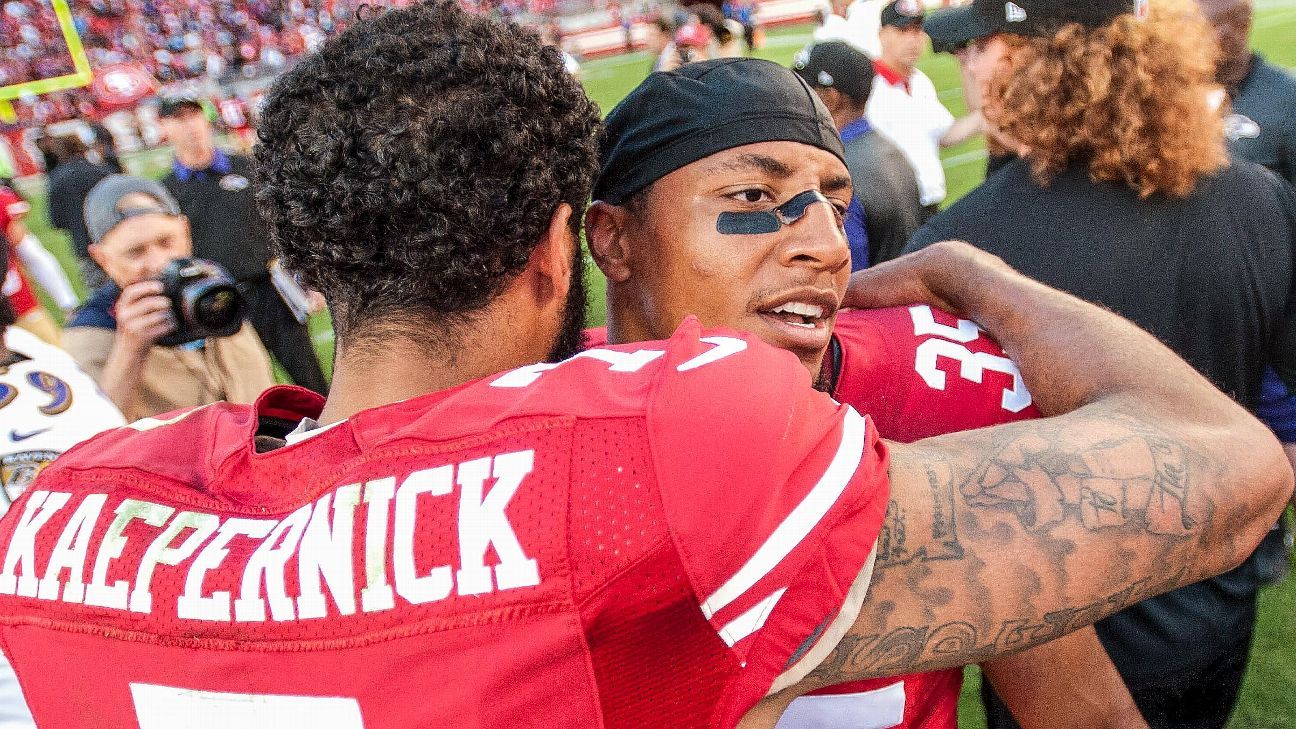The announcement came Friday, seemingly out of nowhere. Colin Kaepernick and Eric Reid have settled their joint collusion grievance with the NFL, ending with little fanfare a case that has transcended the sport into the cultural debates of the country. Let’s read between the lines into what we know, what we think we know — and what we might never know.
What exactly were Kaepernick and Reid claiming?
Kaepernick first filed the grievance in October 2017, saying that NFL teams were in violation of the anti-collusion clause of the collective bargaining agreement (CBA). In the grievance, Kaepernick’s attorney claimed he had gone unsigned because the NFL and its owners “colluded to deprive Mr. Kaepernick of employment rights in retaliation for Mr. Kaepernick’s leadership and advocacy for equality and social justice and his bringing awareness to peculiar institutions still undermining racial equality in the United States.”
But this has gone on for years. Why would either side settle now?
The case was about to reach a new level. Arbitrator Stephen Burbank was going to conduct a hearing to begin resolving the issue, probably early this spring. That would have forced both sides into a semi-public airing of grievances that could have exposed inner workings of league business, along with the details of depositions attorneys have taken with high-level executives and some owners.
So did the NFL think it would lose? Or did it want to avoid discovery?
The latter, most likely. It’s also likely that the NFL viewed a settlement as an important milestone in moving past a controversy that drew the ire of President Donald Trump, among others. But the facts are eye-opening. Kaepernick began taking a knee during the national anthem in 2016 to protest police brutality and system racism. In a league that is in perpetual need of quarterback depth, Kaepernick isn’t known to have received a single firm contract offer since he parted ways with the San Francisco 49ers in May 2017.
It sure seems suspicious.
Of course, but the CBA states explicitly that lack of opportunity cannot in itself be evidence of collusion. From the CBA: “The failure by a club or clubs to negotiate, to submit offer sheets, or to sign contracts with restricted free agents or transition players, or to negotiate, make offers, or sign contracts for the playing services of such players or unrestricted free agents, shall not, by itself or in combination only with evidence about the playing skills of the player(s) not receiving any such offer or contract, satisfy the burden of proof set forth …”
Then what did Kaepernick and Reid need to do to win?
They needed to show that a “club, its employees or agents” had “entered into an agreement” to restrict or limit whether to offer them a contract, according to the CBA. In other words, they needed a “smoking gun,” something league officials could easily have avoided even if they did engage in a conspiracy to keep Kaepernick and later Reid out of the league.
So was there a financial settlement?
The only accurate answer is we don’t know. And because the agreement requires complete confidentiality on both sides, we might never know. But collusion, if found, can carry significant penalties. Had he found the league guilty, Burbank would have determined compensatory damages — the amount a player had been damaged by the collusion. The CBA then calls for Burbank to double those damages in cases of first offense and triple them for a second offense.
We’ll really never know?
Not unless someone breaks the confidentiality agreement. There is a small possibility that the Green Bay Packers‘ annual release of their accounting books could provide a clue. Each team would contribute to any financial settlement that is agreed upon, but it’s more likely that the money would be deducted from league revenues rather than be a line-item charge.
Does this mean Kaepernick will play in the NFL this season?
Not necessarily. Even if he had won the grievance, the CBA does not require him to be signed. The claim of collusion probably isn’t what kept Kaepernick off a roster. Teams appeared to have made up their mind after the 2016 season, long before Kaepernick filed the claim. The NFL has no mechanism to force the signing of a player, and it is it is hard to conceive that the settlement included a job guarantee.
Are we sure Kaepernick wants to play?
He has rarely talked publicly, at least about football, since leaving the 49ers. But in one of his few public comments, in September 2017, he affirmed his desire to continue playing. Kaepernick is known to have continued football-centric workouts, and at 31, he is still relatively young for a quarterback. The new Alliance of American Football reached out to gauge his interest in playing this spring, according to co-founder Bill Polian, but he ultimately did not sign a contract.
Why was Reid involved? Didn’t he play last season for the Carolina Panthers?
Reid joined Kaepernick’s grievance in May 2018 after he went unsigned during the early part of free agency. He agreed to terms with the Panthers in September 2018 and recently signed a three-year contract extension. Reid had joined Kaepernick in kneeling during the national anthem when both players were with the 49ers.
So is this the end of it?
It is the end of the grievance process, and after two years away from the game, Kaepernick faces longer odds to resume his career in a productive way. But as long as Kaepernick is young enough and in shape, it will be fair to question why teams are not demonstrating interest.

